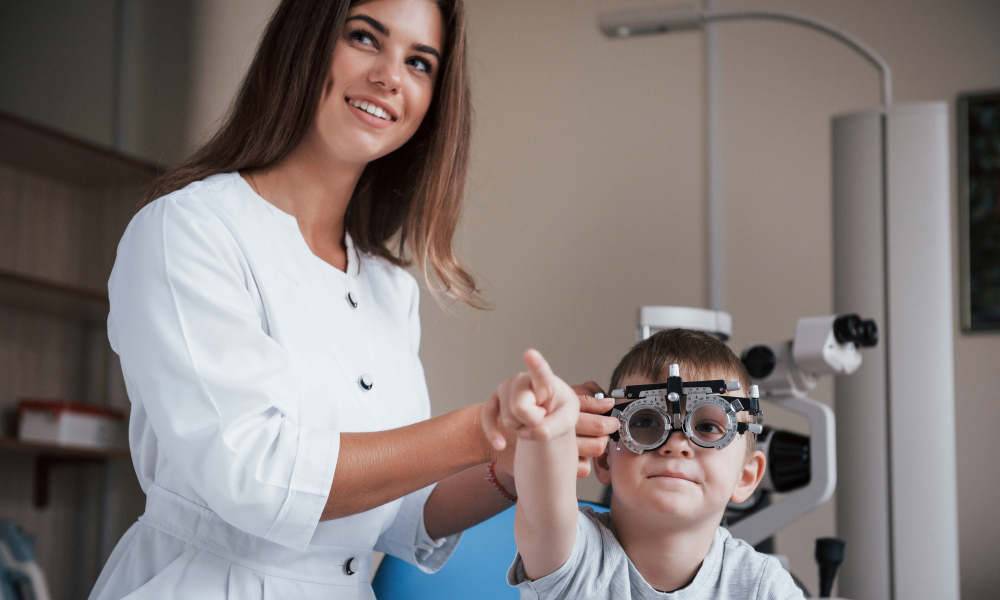
Children’s Eye Exams A Timeline
- Brooklin Vision Care
Did you know that children under the age of 20 in Ontario are covered for a full, comprehensive eye exam annually? OHIP (Ontario Health Insurance Plan) covers this visit for anyone between the ages of 0-19 years old. They also cover any necessary follow up visits, which could include a change in prescription, an eye infection or an eye emergency, as often as needed.
Your child’s eye exam is so much more than a prescription check! During the exam, the optometrist will also check your child’s focusing ability, eye movement control, depth perception, eye coordination, colour vision and eye health. They will also check for crossed or lazy eyes (in addition to checking if the child needs any corrective eyewear!) A thorough family history will also be done to determine if your child is predisposed to any conditions that could affect his/her eye health.
So how are the eyes checked for any issues? The optometrist will perform a penlight exam of eyelids and eyeballs (to check for disease, infection, tearing problems and pupil size). The eye movement check is done with each eye, as well as both together and a light reaction test is also performed to check for a red reflex in the eyes (an abnormal response could indicate a cataract or eye tumour.) When it comes to the eye chart, an optometrist can use pictures or shapes to evaluate your child’s vision if they aren’t familiar with numbers or letters yet.
HERE IS A TIMELINE OF WHEN TO TAKE YOUR CHILDREN FOR EYE APPOINTMENTS:
Infants and Toddlers
(Birth to 24 months)
First eye exam between the ages of 6 and 9 months
Preschool children
(2 to 5 years)
At least one eye exam between the ages of 2 and 5 years
School age children
(6 to 19 years)
Eye examinations should be done annually
If you are concerned your child may have a vision problem, try and book them an appointment shortly after noticing any issues. Signs could consist of:
- Red, itchy or watering eyes
- Sensitivity to light
- An eye that consistently turns in or out
- Squinting, rubbing the eyes or excessive blinking
- A lack of concentration
- Covering or closing one eye
- Irritability or a short attention span
- Holding objects too close
- Avoiding books and television
- Visible frustration
Once your child has started school, vision issues could manifest in different ways such as headaches, avoidance of work, losing their place while reading or omitting and confusing words when reading. Children also performing below their potential could have an undiagnosed vision issue, so it’s incredibly important to get their eyes tested if there are any learning concerns.
COMMON VISION ISSUES THAT CAN ARISE IN CHILDREN CAN INCLUDE:
- Myopia (nearsightedness, blurry vision at a distance)
- Hyperopia (farsightedness, blurry vision up close)
- Astigmatism (distorted vision at all distances)
- Strabismus (crossed eyes, but can be corrected with glasses, vision therapy or surgery).
- Amblyopia (lazy eye, weak vision or vision loss in one eye due to uncorrected prescription.) Amblyopia should be treated early, with glasses, vision therapy, patching or contact lenses, for best results. This usually has to be done before eight years old.
TO HAVE A SUCCESSFUL VISIT TO THE OPTOMETRIST, TRY TO KEEP A FEW THINGS IN MIND, ESPECIALLY IF YOUR CHILD IS QUITE YOUNG.
- Schedule the appointment around nap times
- Do the visit at the beginning of the day, rather than the end
- Avoid fussy times, if possible
- Have parents complete the paperwork at home prior to the visit.
All these things can lead to a positive experience at the optometrist, and make future visits easier for the parents and child.
